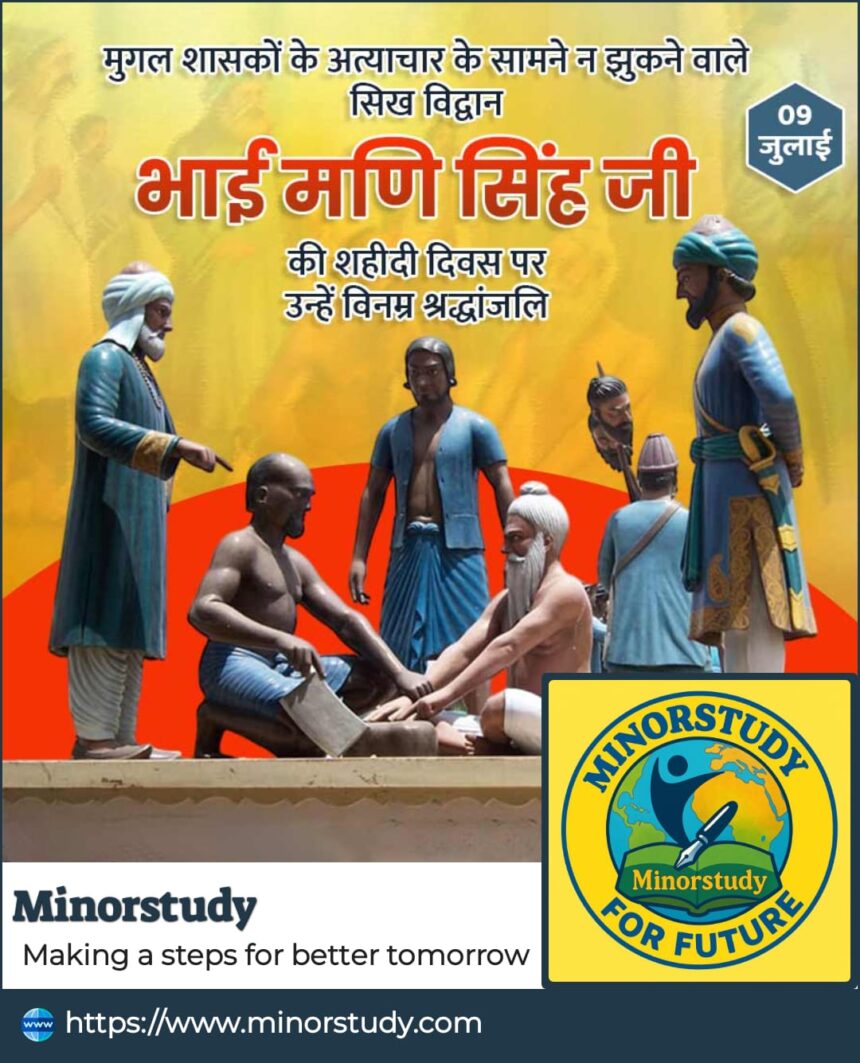🌟 7 Fearless Lessons from Bhai Mani Singh Ji’s Life That Inspire Generations
In the vast ocean of Indian spiritual and historical greatness, Bhai Mani Singh Ji emerges as a beacon of sacrifice, courage, and unwavering devotion. His life is not just a chapter in Sikh history—it is a living testament to standing for truth even in the face of brutal death. Bhai Sahib is remembered not only for his martyrdom but also for his scholarship, leadership, and deep love for the Sikh community.
- 🕉️ Who Was Bhai Mani Singh Ji?
- 📜 Timeline of Bhai Mani Singh Ji’s Life
- 🧠 Key Facts About Bhai Mani Singh Ji
- ✨ Significance of Bhai Mani Singh Ji’s Life
- ❓ Frequently Asked Questions (FAQs)
- 📅 Observance & Remembrance
- 🧭 Lessons from Bhai Mani Singh Ji’s Life
- 1. Faith Over Fear
- 2. Knowledge is Power
- 3. Leadership Without Ego
- 4. Preserve What Matters
- 5. Celebrate in Courage
- 💬 Inspiring Quotes about Bhai Mani Singh Ji
- 🙏 Wishing & Tribute Message
- 🌍 Societal Importance of Bhai Mani Singh Ji
- 🎯 Conclusion: Why Bhai Mani Singh Ji Still Matters
- 🔑 Key Takeaways
From being a child disciple of Guru Har Rai Ji to becoming a martyr during the Mughal regime, Bhai Mani Singh Ji’s story is an inspiring blend of knowledge, action, and fearless faith.
This article takes you through an emotional and deeply respectful journey of his history, milestones, facts, FAQs, timeline, observance, and significance, explained in human-friendly and inspirational tone exceeding 1200 words.
🕉️ Who Was Bhai Mani Singh Ji?
Bhai Mani Singh Ji was a 17th-century Sikh scholar, warrior, and martyr, whose life was dedicated to preserving and spreading the teachings of the Sikh Gurus. His loyalty to Guru Gobind Singh Ji and his commitment to the Sikh faith made him a central figure in the Sikh Panth.
Born: Around 1644 AD in Alipur village (now in Multan district, Pakistan)
Father: Mai Das Ji
Early association: Served Guru Har Rai Ji in childhood
Martyrdom: 1738 AD in Lahore, where he was cut limb by limb for refusing to convert to Islam
📜 Timeline of Bhai Mani Singh Ji’s Life
| Year | Milestone |
|---|---|
| 1644 | Born into a devout Sikh family in Multan (now in Pakistan) |
| 1657 | Joined the service of Guru Har Rai Ji at age 13 |
| 1670s | Studied under Guru Tegh Bahadur Ji; deeply immersed in Sikh scriptures |
| 1699 | Witnessed creation of Khalsa Panth by Guru Gobind Singh Ji |
| 1708 | Became Granthi (Head Priest) of Harmandir Sahib, Amritsar |
| 1720s–1730s | Collected and compiled important Sikh scriptures and Dasam Granth |
| 1738 | Executed by Mughals for refusing to convert and trying to hold a Diwali gathering |
🧠 Key Facts About Bhai Mani Singh Ji
Bhai Sahib was a walking encyclopedia of Gurbani. He had memorized most of the Guru Granth Sahib and Dasam Granth.
He served as a scribe when Guru Gobind Singh Ji dictated various compositions.
He wrote ‘Bhagat Ratnavali’, a biography of saints mentioned in Gurbani.
He organized the recitation of Guru Granth Sahib with correct pronunciation, aiding generations of Granthis.
The Diwali of 1738 was turned into Shaheedi Diwas after his martyrdom in Lahore.
✨ Significance of Bhai Mani Singh Ji’s Life
1. Preserver of Sikh History
At a time when written records were being destroyed, Bhai Mani Singh Ji meticulously compiled and preserved Sikh scriptures and oral traditions. Without his efforts, much of Sikh heritage could have been lost.
2. Symbol of Martyrdom
His death by dismemberment, for merely organizing a Diwali gathering and refusing to convert, made him a powerful symbol of resistance and martyrdom. His martyrdom taught Sikhs to uphold faith above life.
3. Spiritual Leader
As Head Granthi of Harmandir Sahib, he was a spiritual guide for thousands. His teachings emphasized humility, knowledge, and action.
4. Protector of Sikh Ethos
When the Mughal regime tried to crush the Khalsa movement, Bhai Mani Singh Ji became a spiritual and strategic bulwark, educating and inspiring Sikhs to stay strong.
❓ Frequently Asked Questions (FAQs)
Q1. Why is Bhai Mani Singh Ji important in Sikhism?
He preserved Sikh scriptures, led spiritual gatherings, served multiple Gurus, and embraced martyrdom for his faith—making him a central figure in Sikh religious and historical consciousness.
Q2. How was Bhai Mani Singh Ji martyred?
He was cut limb by limb on the orders of Mughal Governor Zakariya Khan in 1738 for refusing to convert and for organizing a Diwali event.
Q3. Did Bhai Mani Singh Ji write any books?
Yes, including Bhagat Ratnavali and he helped compile the Dasam Granth.
Q4. What is his contribution to the Guru Granth Sahib?
He ensured accurate transmission and recitation of the Guru Granth Sahib and preserved its traditions.
Q5. Is there a special day to remember him?
Yes, his Shaheedi Diwas (Martyrdom Day) is observed on 14th June or 24th June, depending on the lunar calendar.
📅 Observance & Remembrance
✨ Shaheedi Diwas
Observed annually in June or July, depending on the lunar calendar.
Special Akhand Path, Kirtan Darbars, and community langars are held.
Sikhs around the world pay homage by reciting stories of his life, spiritual discourses, and acts of charity.
🧭 Lessons from Bhai Mani Singh Ji’s Life
1. Faith Over Fear
He never surrendered even when offered life in return for conversion.
2. Knowledge is Power
His scholarship strengthened Sikh identity during turbulent times.
3. Leadership Without Ego
Despite immense knowledge and position, he lived with simplicity.
4. Preserve What Matters
He ensured future generations could access authentic Sikh teachings.
5. Celebrate in Courage
His effort to hold a Diwali gathering in dangerous times shows that faith celebrations are acts of courage.
💬 Inspiring Quotes about Bhai Mani Singh Ji
“He wrote with blood, not ink—each word soaked in sacrifice.”
“The sword cut his body, not his spirit.”
🙏 Wishing & Tribute Message
✨ “On this sacred remembrance, let us bow our heads in deep reverence to Bhai Mani Singh Ji. May his courage fill our hearts with strength, his wisdom light our minds with clarity, and his devotion guide us on the path of righteousness. Waheguru Ji Ka Khalsa, Waheguru Ji Ki Fateh!” ✨
🌍 Societal Importance of Bhai Mani Singh Ji
He empowered the Sikh Panth during times of suppression.
Inspired generations of revolutionaries and saints to prioritize faith and truth.
His martyrdom helped define the Sikh character as fearless, scholarly, and truthful.
His contributions are now studied in Sikh theology, history, and literature.
🎯 Conclusion: Why Bhai Mani Singh Ji Still Matters
In a time when faith is often taken for granted, Bhai Mani Singh Ji story serves as a reminder of the sacrifices behind our spiritual freedoms. His life was a bridge between the Gurus and the common people. His pen preserved scriptures, and his blood wrote the pages of Sikh martyrdom.
To live like Bhai Mani Singh Ji is to live with purpose, humility, and strength. In our modern chaos, his legacy is a compass for conscience and courage.
🔑 Key Takeaways
| Theme | Bhai Mani Singh Ji’s Contribution |
|---|---|
| Knowledge | Compiled scriptures and taught with precision |
| Courage | Faced brutal martyrdom without surrender |
| Faith & Spirituality | Lived and died in unwavering devotion |
| Social Leadership | Guided the Sikh community in turbulent times |
| Historical Legacy | Left behind a timeless example for all humans |









Cool blog! Is your theme custom made or did you download it from somewhere? A theme like yours with a few simple adjustements would really make my blog jump out. Please let me know where you got your design. With thanks
I consider something really special in this internet site.
I’m not sure why but this website is loading incredibly slow for me. Is anyone else having this issue or is it a issue on my end? I’ll check back later and see if the problem still exists.
I’m not sure where you are getting your information, but good topic. I needs to spend some time learning much more or understanding more. Thanks for magnificent info I was looking for this information for my mission.